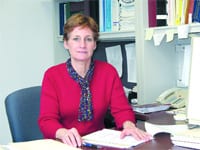In School and in Demand Health Care Job Market Bright for the Class of 2007
The nursing shortage has been one of the top American health care stories over the past five years, but the understaffing doesn’t stop there. Hospitals and other organizations have struggled for some time to fill specialties ranging from respiratory therapy to pharmacy.
Which is why these are good days to be a college student studying in a health field. Across the board, Western Mass. colleges report plenty of job opportunities for the class of 2007 — with students often choosing among several offers long before they’re measured for cap and gown.
For example, Susan Schneider, who chairs the Clinical Laboratory Sciences Department at Springfield Technical Community College, said her students are entering a very upbeat job market, with every student who wants a job able to find one months before graduation.
“The projections are that one-third of the workforce in clinical laboratories across the country will be retiring in the next three to seven years,” she added. “That means plenty of opportunity and a great demand for students in this field.”
A check of U.S. Department of Labor projections suggests that virtually every “health diagnosing and treating occupation,” a category that does not include physicians and typically requires just a four-year degree, will be in higher-than-average demand over the next five to seven years when compared with the job market as a whole.
The reasons vary. The aging of the population will no doubt increase the need for audiologists, nutritionists, and rehabilitation specialists, while ever-expanding hospitals continuously report shortages in fields ranging from radiology to (of course) nursing. Many hospitals, ever cost-conscious, are leaning more on physician assistants in surgical settings, creating new opportunities there as well.
The bottom line? These are good times to be seeking employment in health care.
Age Spots
Some of the opportunity for health care graduates is a product of changing national demographics, specifically a population that’s living longer with chronic health issues. That bodes especially well for graduates of three key health divisions at American International College in Springfield: physical therapy, occupational therapy, and nursing.
Carol Jobe, dean of the School of Health Sciences, said 90{06cf2b9696b159f874511d23dbc893eb1ac83014175ed30550cfff22781411e5} of the class of 2007 are taking jobs here in Western Mass., reflecting the fact that most AIC students have local roots. And they’re keenly aware of the opportunities being presented these days.
“People are living longer, and rehabilitation provides them with the quality of life they need and seek,” Jobe said. “Plus, people are more active and health-conscious; they want to be able to do things like hiking, swimming, and fishing. They don’t think they’re too old.” But, she said, they often need the services of PTs, OTs, and nurses to help them maintain the health necessary to live full lives.
All signs point to nurses being in demand over the next decade. The current shortage and high number of expected retirements would keep the field fertile even if the number of nursing positions doesn’t change. But the Department of Labor says it will change, projecting nursing to add the second-most positions of all occupations in the country over the next seven years.
That poses a challenge for hospitals, even those based in Western Mass., home of several healthy college nursing programs. And it makes relationships between schools and hospitals more important than ever.
“We found many years ago that the best recruitment for employees was to develop linkages with academic institutions,” said Mary Kelleher, vice president of Human Resources at Holyoke Medical Center. “So we’ve taken students during their academic years into internship-type roles, whether it be in nursing, radiology, or some other clinical discipline.”
It’s a common model in the region, and nationwide as well. Hospital administrators say such activity is a must at a time when demand for quality employees is greater than the candidate pool — not only in nursing but in other short-handed professions.
“We have relationships with five of the local colleges,” said Maureen Lanzoni, director of Clinical Practice at Mercy Medical Center. “And Mercy is fortunate to have a partnership with Elms College, where we have faculty that actually work at Mercy and also teach for the Elms.”
Jim Keefe, vice president of Inpatient Services at Holyoke Medical Center, said forming relationships with interning students now certainly pays recruiting dividends later. “That experience has a big influence on whether or not to consider us as an employer,” he said.
“We’re providing opportunities for students to have experiences in the work setting in their chosen field that does not require them to be licensed yet,” Kelleher added. “It could be assisting with a patient, getting them ready for an exam, something like that. That way, the student develops a comfort level and a loyalty with a potential employer.”
The Race Is On
These types of partnerships aren’t new, but what is changing is the way graduates in some fields are finding work. In short, employers are short-circuiting traditional venues such as classified advertising and coming after students where they are.
For example, Marianne Joyce, Occupational Therapy chair at STCC, cited Department of Labor statistics in noting that the market for OT assistants is excellent, and will remain so in the coming years. “Right now occupational therapy practitioners are in demand, and facilities are offering great benefit packages, including sign-on bonuses and continuing education money,” she said.
“Unfortunately, the qualified program applicant doesn’t always know this. I think people scan the job ads in the local papers looking for job postings and don’t see many for occupational therapy assistants because most jobs are posted in our professional journals or Web sites.”
Tina Acker, associate director of Career Services at UMass in Amherst, said the university’s internal job postings run the gamut from hospitals to the Mass. Department of Health to internship opportunities at nursing and rehab centers — and there are plenty of them.
“The direct-care fields are big right now, from the basic level of a home health care aide into per-diem nurses and senior staff,” she said.
For hospitals and other employers, retention is just as important as recruiting, if not moreso. Lanzoni touted Mercy’s orientation program, which pairs new nurses with instructors for the first year.
“Statistically, most new nurses leave their first position within the first year,” she said. “But with the support we’re giving them, we’ve been able to maintain a 100{06cf2b9696b159f874511d23dbc893eb1ac83014175ed30550cfff22781411e5} retention rate for new nurses.”
Meanwhile, those first jobs, whether in nursing or another health care field, aren’t that difficult to find. “I think this is one of those fields,” Acker said, “where you can — I won’t say write your own ticket, but you can expect to have an easier time finding a job.”
In short, if it’s good to be wanted, the health care class of 2007 is feeling pretty good right now.



